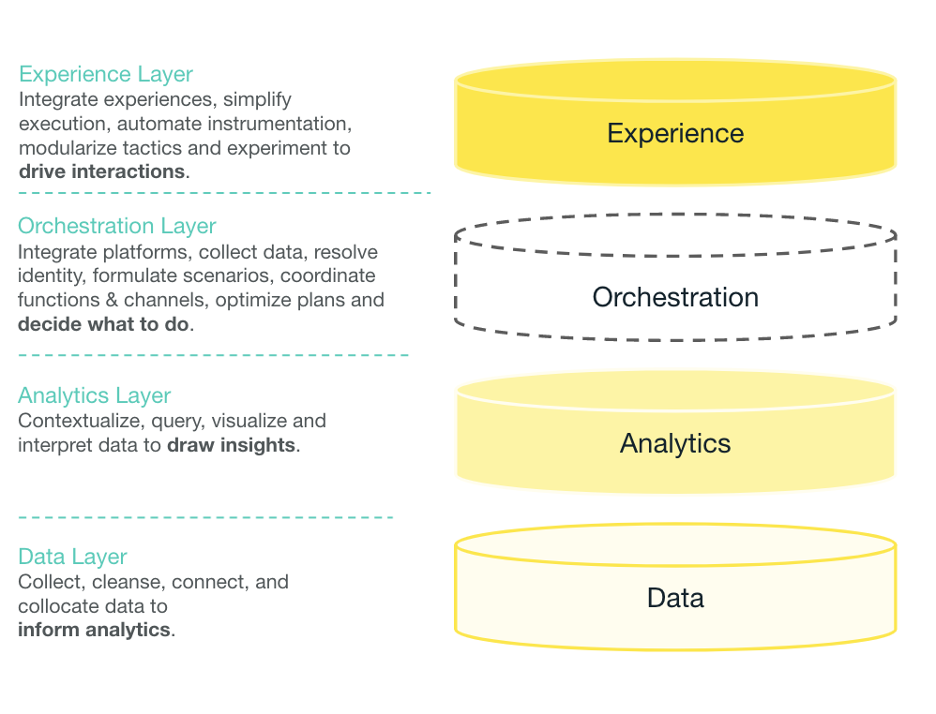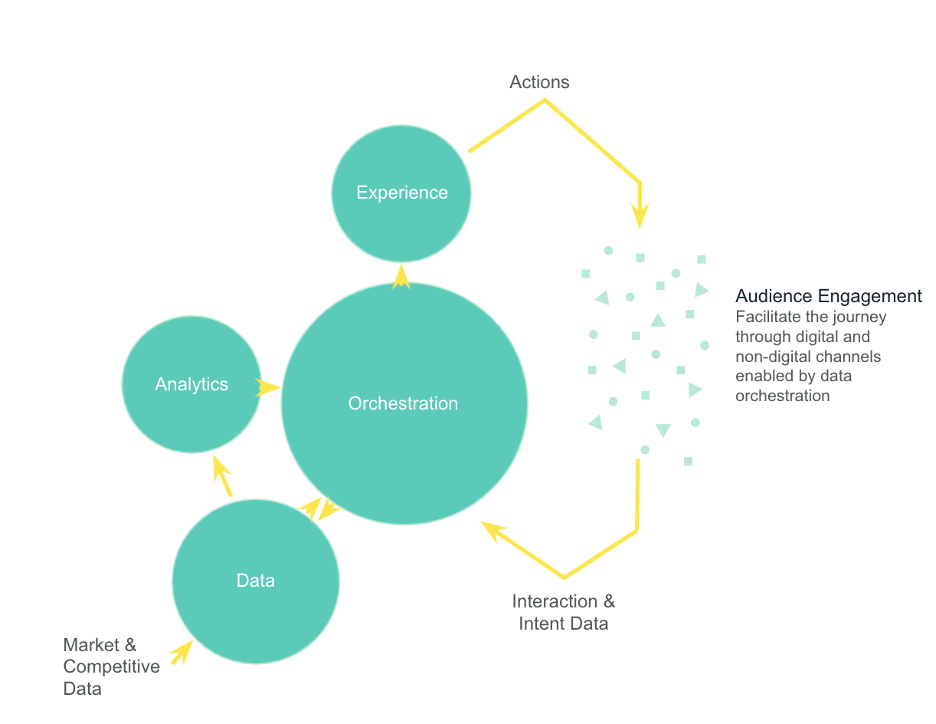How Marketing Data Should Flow Through Your MarTech Stack – A Precursor to CDP

Marketers are rarely data experts, but the best marketers I know have a keen handle on their data. I’ve personally been up to my elbows in spreadsheets that push the limits of Excel rows and columns to understand my clients’ data and finagle how they can gain something from it. I like to make complex topics simple. Thus, using those painful experiences, I’ve developed a simple description of technology layers, where data is the foundation. I use these with our clients to explain how marketing teams should structure their data to do their jobs better.
Levelset on Marketing Technology Layers
There are four layers to consider:
- Data Layer: The foundational layer for all the nitty-gritty data. This contains all your fields and values.
- Analytics Layer: The visualization layer which ingests all the nitty-gritty data for the purpose of drawing insights.
- Orchestration Layer: The connection layer, where you’re connecting data from various first, second and third party sources to decide what to do next.
- Experience Layer: The execution layer, where you put marketing campaigns out into the universe, which creates more data that you send down to your data layer.

It’s insinuated in the fourth point above, but bears repeating; these layers are cyclical. Consider this diagram as another lens to look at data through.

As your customers engage (or choose not to) with your marketing, your technology systems are constantly monitoring, collecting and then running that information through your systems to come to conclusions that you then use to campaign more and create more data to ingest.
The Orchestration Layer is Often Missing
The most common challenge we see when we assess Tech stacks, especially in MarTech, is the missing, or ineffective orchestration layer. Many technologies bring marketers close to the function of the orchestration layer, but miss critical points that frustrate marketers and lead to poor customer experiences.
For example, with marketing automation platforms (MAPs), most organizations are integrating their MAP with their Customer Relationship Management (CRM) products. But very few bring all owned media and first party data into these systems. For instance, many miss app-side data. Consider how many SaaS companies bring user data from their app into CRM and MAP. Consider how many companies bring contract-level data in from their billing system. These data points are critical to crafting the best customer experience, but are often missing.
Why?
Sometimes the technology choices are to blame. Some technologies lack open APIs to transfer data. Sometimes it’s a skills gap. Perhaps the technology has the ability, but your team lacks the knowledge to put the pieces together. Maybe you just haven’t prioritized it or budgeted for it yet. I could go on and on, but the gist is this: If you’re not nailing the orchestration layer, your customers are suffering.
Fixing the Orchestration Layer
You might expect me to have a very consultancy answer to how to solve for this. Consultants love to say “it depends.” But really, the solution to this is straight-forward and it’s Customer Data Platforms (CDPs).
Here’s the definition of CDP from our friends at Tealium (one of my favorite CDPs):
The CDP Institute defines a Customer Data Platform as “packaged software that creates a persistent, unified customer database that is accessible to other systems.” Basically it’s a prebuilt system that centralizes customer data from all sources and then makes this data available to other systems for marketing campaigns, customer service and all customer experience initiatives.
The right way to handle a CDP is to make sure that you have a comprehensive handle on your audiences and ideal customer profiles in your analytics layer. Then build those audiences in your orchestration tool – AKA your CDP.
This sets you up for data flow that ultimately gets pushed into the experience layer and deployed. The system gathers further data around that person’s experience and the CDP collects it, then re-aggregates their profile. In an ideal world, it’s a positive loop that keeps getting more and more effective with each lap. But guess what? You can access this “ideal world” of using a CDP if you pay attention to each layer, and make sure not to miss a focus on orchestration.
You Still Must Understand Your Audience
I mentioned above that the best way to implement a CDP is by mirroring your buyers in your layers. But it’s so critical, I’m repeating the message in its own section. If you do not understand your buyer, I will always recommend a Customer Science project first.
In this exercise, you strive to know everything you can about your customer in a data profile. This should not be an abstract, written out persona; it should instead be a data-driven profile that will inform all the layers of your structure.
Consider the below graphic, which paints the picture of collecting user data, then building audiences and planning the journey. This is often an exercise that challenges both quantitative data, as well as qualitative anecdotes, learnings and experiences with your buyers. All this feeds the orchestration layer and ultimately leads to a better customer experience.

What Holds Companies Back?
So, why wouldn’t an organization take full advantage of using customer science and a CDP in these ways? All too often, fear of change holds them back. They’re used to their existing tool set and have done their best with it so they think it “works.” They want to stay comfortable and not have to bring on new technology and create new processes.
There’s also the monetary component, since doing this right can be very expensive. But remember that you don’t need to re-architect all your systems when you go this route; you can connect it all because the CDP essentially has data pipes that pull data in and push it out. You get to determine the flow. And, a CDP is your best bet to solve a lot of your data problems and enjoy excellent results. It’s important to note, too, that since CDPs are a user-generated interface for moving data, you don’t have to worry about getting an engineer or data analyst to handle it. Marketers are more than capable of accessing the data via drag and drop interfaces that are user-friendly, and manipulating data and audiences like an expert.
We highly recommend considering implementing a CDP and using it strategically, according to the structure laid out here. It can be incredibly powerful in elevating your marketing efforts, customer relationships and, ultimately, your revenue engine.





